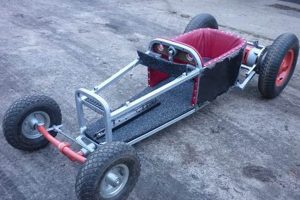The endeavor of constructing an electric bicycle from individual components represents a growing trend in personal transportation. This activity involves selecting and integrating parts such as a motor, battery, controller, and wiring with a standard bicycle frame to create a customized, electrically assisted vehicle. An individual might, for instance, adapt a mountain bike into an electric-powered commuter for enhanced hill climbing ability.
This approach offers several advantages, including cost savings compared to purchasing pre-built models and the ability to tailor the bicycle to specific needs and preferences. Historically, the movement has been fueled by advancements in battery technology and the increased availability of affordable electric components. Custom builds provide greater control over performance characteristics, such as range and power output.
The following sections will delve into the key considerations for embarking on such a project, including component selection, safety precautions, and legal regulations. The goal is to provide a comprehensive overview to aid individuals in successfully creating their own personalized electric-powered bicycle.
Essential Considerations for Electric Bicycle Self-Assembly
Successful completion of a personal electric bicycle project requires careful planning and execution. The following guidelines outline critical aspects to consider during the building process.
Tip 1: Component Compatibility: Verify the compatibility of all selected components, including motor voltage, battery capacity, and controller specifications. Mismatched components can lead to system failure or safety hazards.
Tip 2: Frame Integrity: Assess the bicycle frame’s suitability for electric conversion. Frames made of durable materials, such as steel or aluminum, are recommended to withstand the added weight and stress of electric components.
Tip 3: Battery Mounting: Secure the battery pack firmly to the bicycle frame, ensuring proper weight distribution and preventing movement during operation. A robust mounting system is essential for safety and longevity.
Tip 4: Wiring and Connections: Employ proper wiring techniques and secure all electrical connections. Use appropriate gauge wiring and weatherproof connectors to prevent short circuits and ensure reliable power delivery.
Tip 5: Braking System Enhancement: Upgrade the bicycle’s braking system to accommodate the increased weight and speed of the electric conversion. Disc brakes are generally recommended for enhanced stopping power.
Tip 6: Motor Selection: Choose a motor appropriate for the intended use. Hub motors offer ease of installation, while mid-drive motors provide improved torque and climbing ability.
Tip 7: Safety Equipment: Prioritize safety by wearing a helmet and utilizing appropriate safety gear during operation. Ensure the bicycle is equipped with functional lights and reflectors for enhanced visibility.
These guidelines are crucial for building a safe, reliable, and enjoyable electric bicycle. Careful attention to detail and adherence to best practices will contribute to a successful project.
The subsequent sections will cover advanced topics related to electric bicycle customization and optimization.
1. Motor specifications
Motor specifications are a critical determinant of a self-assembled electric bicycle’s performance. Motor power, voltage, and torque directly impact the vehicle’s acceleration, top speed, and hill-climbing ability. For example, a motor with a higher voltage rating paired with a compatible battery can deliver increased power output, resulting in enhanced performance on steep inclines. Inadequate motor specifications may lead to insufficient power, overheating, and ultimately, system failure.
The selection of an appropriate motor necessitates a thorough understanding of the intended use. A lightweight city commuter may require a lower-powered motor than a rugged off-road vehicle designed for challenging terrains. Moreover, motor efficiency plays a pivotal role in maximizing battery life and overall range. High-efficiency motors reduce energy consumption, enabling riders to travel greater distances on a single charge. Brushless motors, for instance, generally offer superior efficiency and longevity compared to brushed alternatives.
The understanding of motor specifications is, therefore, paramount for a successful electric bicycle project. Careful consideration of power, voltage, torque, and efficiency will ensure that the finished product meets the rider’s specific needs and delivers a reliable and enjoyable riding experience. Overlooking these details can result in a substandard or even unsafe electric bicycle.
2. Battery capacity
Battery capacity represents a fundamental parameter in the design and functionality of self-assembled electric bicycles. It directly influences the range achievable on a single charge, impacting the practical utility of the vehicle for transportation and recreation. Proper determination of appropriate battery capacity is critical for fulfilling the intended purpose of the converted bicycle.
- Range Determination
Battery capacity, measured in watt-hours (Wh) or amp-hours (Ah), dictates the maximum distance an electric bicycle can travel before requiring recharging. A higher capacity battery offers extended range, suitable for longer commutes or recreational rides. For instance, a 500 Wh battery might provide a range of 20-40 miles depending on factors like terrain, rider weight, and motor power. The selection of battery capacity should align with the typical distance the bicycle will be used to cover, ensuring practicality and minimizing the need for frequent charging.
- Battery Weight and Size
Increased battery capacity typically correlates with increased weight and physical size. A larger battery can impact the bicycle’s handling characteristics and overall aesthetics. Careful consideration must be given to the bicycle frame’s capacity to accommodate the battery and the rider’s preference for weight distribution. Compact battery designs that maximize energy density are often preferred to minimize the impact on handling and appearance. Trade-offs between range, weight, and size are inherent in the selection process.
- Cost Considerations
Battery cost is directly proportional to its capacity. Higher capacity batteries represent a significant investment in the electric bicycle conversion. Budgetary constraints often influence the choice of battery capacity. Individuals may opt for a lower capacity battery to reduce initial costs, accepting a shorter range as a compromise. Long-term considerations, such as battery lifespan and replacement costs, should also be factored into the overall cost analysis.
- Voltage Compatibility
Battery voltage
must be compatible with the motor and controller specifications. Mismatched voltage can result in system failure or reduced performance. Standard electric bicycle batteries operate at voltages such as 36V or 48V. Selecting a battery with the correct voltage is essential for proper system operation and to prevent damage to electrical components. Thorough verification of voltage compatibility is a fundamental step in the electric bicycle construction process.
The interplay of these facets underscores the importance of carefully considering battery capacity when constructing a self-assembled electric bicycle. The final choice should reflect a balance between desired range, physical constraints, budgetary limitations, and electrical compatibility, ultimately contributing to a functional and enjoyable riding experience. Ignoring these factors can lead to a compromised or even unusable electric bicycle.
3. Frame Strength
Frame strength is a paramount consideration in the construction of a self-assembled electric bicycle. The frame serves as the foundational structure, bearing the combined weight of the rider, the electric motor, battery, and associated components. Insufficient frame strength can compromise safety, handling, and the overall lifespan of the vehicle.
- Material Composition
The material used in the frame construction significantly influences its strength and durability. Steel frames, known for their robust nature and ability to withstand stress, are a common choice for electric bicycle conversions. Aluminum frames offer a lighter alternative but may require thicker tubing to achieve comparable strength. Carbon fiber frames, while exceptionally lightweight and strong, are typically more expensive and may not be suitable for all conversion projects. The material selection should align with the intended use and weight requirements of the electric bicycle. For example, a heavier rider or one who anticipates frequent off-road use would benefit from a steel or reinforced aluminum frame.
- Frame Geometry and Design
The geometric design of the frame plays a critical role in distributing stress and maintaining structural integrity. Frames designed with reinforced joints and strategic gusseting can withstand greater loads and resist deformation. The presence of mounting points for the motor and battery can also impact frame strength, necessitating careful consideration of load distribution. For instance, mounting a heavy battery high on the frame can raise the center of gravity and affect stability. Frame geometry should be optimized to accommodate the added weight and forces associated with electric conversion.
- Load Capacity and Stress Analysis
Determining the frame’s load capacity is essential to ensure it can safely support the combined weight of the rider, electric components, and any additional cargo. Stress analysis, either through calculations or finite element analysis, can identify potential weak points and areas of high stress concentration. For example, the head tube and bottom bracket area are often subject to significant stress during braking and acceleration. Reinforcing these areas can prevent premature failure. The specified load capacity should exceed the anticipated total weight by a safety margin to account for dynamic loads and unforeseen stresses.
- Welding Quality and Construction Techniques
The quality of welding and other construction techniques directly impacts the frame’s overall strength. Properly executed welds create strong, durable joints that can withstand repeated stress. Poorly executed welds can introduce stress concentrations and lead to premature failure. Inspection of welds for porosity, cracks, and proper penetration is crucial. Professional welding services are often recommended for critical joints to ensure structural integrity. For instance, TIG welding typically provides superior strength and aesthetics compared to MIG welding for frame construction.
The interconnectedness of these facets demonstrates the critical role frame strength plays in the success and safety of a self-assembled electric bicycle. The selection of appropriate materials, optimized frame geometry, careful load capacity calculation, and high-quality construction techniques are all essential considerations. Neglecting frame strength can lead to structural failure, compromising the safety of the rider and the longevity of the electric bicycle. The frame is the foundation of a reliable and enjoyable electric bicycle, and its strength should be a paramount concern throughout the construction process.
4. Wiring safety
Electrical wiring forms the nervous system of any self-assembled electric bicycle. Consequently, wiring safety is not merely an ancillary concern but a foundational element crucial to the overall functionality, reliability, and safety of the entire project. Compromised wiring can lead to a spectrum of issues, ranging from degraded performance to catastrophic system failures and safety hazards.
- Correct Gauge Selection
The gauge, or thickness, of the wiring must be appropriately sized to handle the electrical current demands of the motor and other components. Undersized wiring can overheat, leading to insulation breakdown, short circuits, and potential fires. For example, a motor drawing 20 amps of current requires a thicker gauge wire than a low-power lighting system. Consult appropriate wiring charts and adhere to manufacturer specifications to ensure the selected gauge can safely handle the anticipated current load. This is a fundamental step in ensuring the longevity and safety of the electrical system.
- Proper Insulation and Protection
Wiring insulation provides a crucial barrier against electrical shorts and protects against environmental factors such as moisture and abrasion. Damaged or inadequate insulation can create pathways for electrical current to escape, posing a shock hazard to the rider and potentially damaging sensitive electronic components. Applying heat shrink tubing or using properly rated electrical tape to protect exposed wires and connections is paramount. Routing wires away from sharp edges and moving parts minimizes the risk of abrasion damage. Using conduit or protective sleeving can further enhance insulation and protect wires from the elements.
- Secure Connections and Terminations
Loose or poorly made electrical connections create points of high resistance, leading to heat buildup and potential connection failure. Securely crimping connectors and ensuring proper contact is critical for reliable electrical conductivity. Using appropriate connectors, such as Anderson Powerpoles or weatherproof connectors, ensures a robust and reliable connection. Soldering connections, when done properly, can provide a strong and corrosion-resistant bond. Regularly inspect connections for corrosion or looseness, and promptly address any issues to prevent performance degradation or system failure.
- Overcurrent Protection and Fusing
Fuses and circuit breakers provide essential overcurrent protection, safeguarding against short circuits and electrical overload. A correctly sized fuse will interrupt the electrical circuit if an excessive current is detected, preventing damage to components and reducing the risk of fire. The fuse rating should be appropriate for the circuit
it is protecting and located as close as possible to the battery or power source. Incorporating a master fuse on the main power line is a best practice for overall system protection. Regularly check the fuse integrity and replace any blown fuses with the correct replacement to maintain the intended level of protection.
These aspects of wiring safety, taken collectively, underscore the importance of meticulous planning and execution when constructing a self-assembled electric bicycle. Neglecting any of these details can compromise the integrity of the entire system and pose significant safety risks. A robust and well-executed wiring system is not only essential for optimal performance but also for ensuring the safety and longevity of the electric bicycle.
5. Braking efficiency
The effectiveness of a braking system is fundamentally crucial in the context of self-assembled electric bicycles. Increased weight and potential for higher speeds, relative to conventional bicycles, necessitate braking systems capable of providing reliable and responsive deceleration. Insufficient braking performance can result in increased stopping distances, posing a significant safety risk to the rider and others. For instance, an electric bicycle traveling at 20 mph requires a considerably more robust braking system than a standard bicycle to achieve comparable stopping distances.
Several factors influence braking efficiency in these systems. These include the type of brakes used (e.g., rim brakes, disc brakes, hydraulic disc brakes), the quality of the brake pads, and the condition of the braking surfaces. Disc brakes, particularly hydraulic disc brakes, are generally preferred for electric bicycles due to their superior stopping power, especially in wet conditions. Upgrading to high-quality brake pads can significantly improve braking performance, providing better grip and reduced fade. Regular maintenance of the braking system, including inspection of brake pads and cables, is essential to ensure consistent performance.
In conclusion, braking efficiency is not a mere detail but a safety-critical component in the realm of self-assembled electric bicycles. Careful selection, proper installation, and consistent maintenance of the braking system are paramount. Neglecting braking efficiency can have severe consequences, underscoring the need for rigorous attention to this aspect during the building process. Prioritizing braking performance contributes significantly to the overall safety and reliability of the finished electric bicycle.
6. Controller compatibility
Controller compatibility stands as a pivotal element in the successful construction of any self-assembled electric bicycle. The controller serves as the central processing unit, governing the flow of electrical energy from the battery to the motor and coordinating various system functions. A properly matched controller ensures efficient operation, optimal performance, and safeguards against potential component damage.
- Voltage Matching
The controller’s voltage rating must precisely align with the battery voltage. A mismatch can result in either insufficient power delivery, leading to reduced motor performance, or over-voltage conditions, which can permanently damage the controller and potentially the motor. For instance, utilizing a 36V controller with a 48V battery will likely result in controller failure, while a 48V controller with a 36V battery will limit the system’s overall power output. Accurate voltage matching is non-negotiable for a functional and reliable electric bicycle.
- Motor Type Compatibility
Electric bicycle controllers are designed to operate with specific types of motors, such as brushed DC motors, brushless DC motors (BLDC), or hub motors. Each motor type has unique operational characteristics that necessitate specific control algorithms. Using an incompatible controller can lead to erratic motor behavior, reduced efficiency, and potential damage to the motor windings. For example, attempting to use a BLDC controller with a brushed DC motor will not produce the desired result, as the controller’s commutation logic will not align with the motor’s internal structure.
- Current Limiting and Protection
The controller’s current limiting capabilities are critical for protecting the motor and battery from overcurrent conditions. Exceeding the motor’s maximum current rating can lead to overheating and eventual failure. The controller must be programmed to limit the current draw to within safe operating parameters. For instance, if a motor is rated for a maximum current of 20 amps, the controller should be configured to prevent the current from exceeding this value, even under heavy load conditions. This protection mechanism is vital for extending the lifespan of the motor and battery.
- Sensor Integration and Communication
Many advanced electric bicycle controllers incorporate sensors, such as throttle position sensors (TPS), pedal assist sensors (PAS), and temperature sensors. These sensors provide feedback to the controller, enabling it to optimize motor performance and respond to rider inputs. Compatibility with these sensors is essential for utilizing advanced features such as pedal assist and cruise control. A lack of sensor compatibility can limit the functionality of the electric bicycle and reduce its overall usability. For example, a controller without PAS support will not be able to provide assistance based on the rider’s pedaling effort, requiring the rider to rely solely on the throttle.
Consequently, meticulous attention to controller compatibility is a prerequisite for the successful construction of a self-assembled electric bicycle. Proper matching of voltage, motor type, current limiting, and sensor integration is essential for ensuring safe, efficient, and reliable operation. Neglecting controller compatibility can lead to system malfunctions, reduced performance, and potential component damage, emphasizing the need for thorough planning and careful component selection.
Frequently Asked Questions
This section addresses common inquiries regarding the design and construction of electric bicycles from individual components, providing clear and concise answers to prevalent questions.
Question 1: Is prior electrical engineering experience required for electric bicycle self-assembly?
While formal electrical engineering training is not strictly mandatory, a fundamental understanding of electrical circuits, wiring diagrams, and safety protocols is highly recommended. Familiarity with basic tools and measurement instruments is also beneficial.
Question 2: What is the typical range achievable with a self-assembled electric bicycle?
The range varies depending on battery capacity, motor power, rider weight, terrain, and riding style. A battery with a capacity of 500 watt-hours typically provides a range of 20-40 miles under optimal conditions.
Question 3: Are there legal regulations governing the use of self-assembled electric bicycles?
Regulations vary by jurisdiction. Most regions classify electric bicycles as either bicycles or low-speed electric vehicles, with specific requirements regarding motor power, speed limits, and licensing. Consult local laws before operating a self-assemble
d electric bicycle on public roads.
Question 4: What are the most common safety hazards associated with electric bicycle self-assembly?
Common hazards include electrical shocks from exposed wiring, battery fires due to improper charging or handling, and mechanical failures resulting from inadequate frame reinforcement or improper component installation.
Question 5: Can regenerative braking be incorporated into a self-assembled electric bicycle?
Yes, regenerative braking is possible with certain motor and controller combinations. This feature allows the motor to function as a generator during braking, converting kinetic energy back into electrical energy to recharge the battery and reduce wear on mechanical brakes.
Question 6: What are the recommended tools for electric bicycle self-assembly?
Essential tools include a multimeter for electrical testing, wire strippers and crimpers for making secure connections, a soldering iron for joining wires, a bicycle repair stand, and a comprehensive set of wrenches, sockets, and screwdrivers.
This FAQ section provides a concise overview of key considerations for electric bicycle construction. Thorough research and adherence to best practices are crucial for ensuring a safe and successful project.
The subsequent section will explore advanced topics in electric bicycle customization and performance optimization.
Conclusion
The foregoing analysis has elucidated critical aspects of constructing electric bicycles from individual components. This process, while offering opportunities for customization and potential cost savings, necessitates a thorough understanding of electrical systems, mechanical engineering principles, and relevant safety regulations. Component selection, wiring techniques, and braking system optimization emerge as particularly vital considerations for ensuring a safe and functional vehicle.
The pursuit of building an electric bicycle represents a commitment to both personal transportation innovation and responsible engineering practices. Success in this endeavor hinges upon diligent research, meticulous execution, and an unwavering focus on safety. The continued advancement of electric vehicle technology promises further refinement and accessibility in the realm of personal electric mobility.







